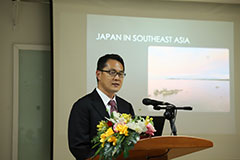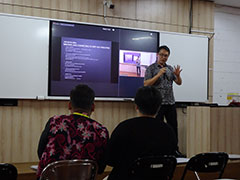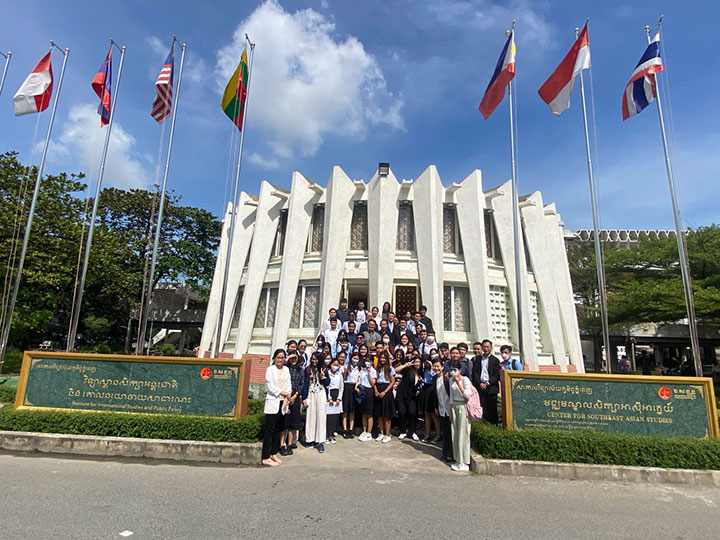Nobuhiro Aizawa
Associate Professor
Department of Cultural Studies, Kyushu University
The author delivered in-person lectures in Cambodia and Indonesia in 2023, to support the aim of the JICA Chair Project: learning from Japan’s modern history. The lectures at the University of Belgrade in Serbia and Sofia University in Bulgaria in 2022 were delivered online. Therefore, it was a special experience to visit Cambodia and Indonesia to deliver lectures in person. The author spoke at the Royal University of Phnom Penh and the Institute of Diplomacy and International Relations (NIDIR) in Cambodia, the University of Indonesia, and a training institute of the Ministry of Foreign Affairs in Indonesia.

“Japan in Asia, Japan in Southeast Asia”: Learnings from discussions with students
The lecture series, titled “Japan in Asia, Japan in Southeast Asia,” focused on Japan’s perspective regarding the identification of changes that took place over the past three years, in the long history of relations between Japan and Asia, and between Japan and Southeast Asia. These changes included the COVID-19 pandemic, the rivalry between the United States and China, and the reemergence of nationalism. Japan has experienced global crises, changes in the international order, and the rise of nationalism over the past 50 to 100 years, a period that defined its relationships with Asia and Southeast Asia. The author compared these changes with those that occurred over the past three years to identify the similarities and differences between them.
Three questions dominated the author’s discussions with students. The first question is how Japan managed to gain the trust of Southeast Asia. There are countries in Asia whose relationship with Japan is still hampered by the negative legacy of its colonial rule, but there are also countries for which this experience is no longer an impediment. What is the cause of this difference?
The second question explores the view that Japan’s relationship with Asia is dictated by its relationship with the United States, and that Japan itself is only a junior partner that does the bidding for the United States.
The third question revolves around Japanese culture, including food and lifestyle, which has fascinated many people. The students have expressed concerns about the future of Japanese culture now that Japan faces a declining birthrate and an increase in aging population.
Communication capabilities are key to fostering a mutual understanding between Japan and Southeast Asian countries.
In tackling the first and second questions, the author found that students in Cambodia and Indonesia learn about Japan’s political history and foreign policy predominantly through English-language media. This implies that Southeast Asian students’ view of Japan is filtered through the lens of the U.S. and British media. This is inevitable because search learning through the internet has become commonplace in the contemporary age and English is the dominant language used online learning platforms. Many search results focus on the history of war and contemporary geopolitics. Therefore, two aspects of Japan form the basis of how students in Indonesia and Cambodia view the nation: Japan as an invader of Asian countries during World War II, and Japan as a part of the U.S. camp, i.e., a member of QUAD and FOIP. The media does not shed light on the unique initiatives that Japan has pursued to establish relationships with Southeast Asia in the past. These initiatives, including development cooperation, financial cooperation, and peacebuilding in Cambodia and Mindanao, were significantly different from those of the United States. This is why people find it puzzling that Japan is “trusted.”

A picture of Dr. Nobuhiro Aizara lecturing at a university in Indonesia
Questionnaire surveys targeting policy elites and experts who have direct contact with Japan may indicate that these people trust Japan. However, such trust cannot be observed among students in Indonesia or Cambodia. This is primarily due to a lack of communication by Japan. The image that Japan has created for itself based on development cooperation, economic cooperation, and private-sector investments is fading because of the nation’s relative economic decline.
During this transitional period when Japan is seeking to establish a new image for itself, an effective way to collect information about Japan and learn about the country is through the lens of other countries.
It should be noted that this approach is similar to the way in which Japanese people learn about Southeast Asia. Japanese students’ understanding of Southeast Asia is based on the coverage of the U.S. and British media and the image they propagate. For example, these media tend to regard Southeast Asia only as an arena for the U.S.-China power struggle. As a result, attention is drawn to whether countries are leaning toward China or toward the United States, with information focused on China’s influence on port projects in Cambodia or high-speed railway projects in Indonesia.
The author has unexpectedly learned, by directly interacting with students through JICA Chair, how English search learning impacts the mutual understanding between Japan and Southeast Asia. This was an important insight for future historical and educational exchanges, as well as for improving Japan’s media policies.
Re-establishing “Japan in Asia” through dialogue
While exploring the third question, the author also learned that younger people in Indonesia and Cambodia garner deep concerns about the current state of Japan. This is a cause of optimism, rather than pessimism. It implies that once we come to terms with the reality that Japan’s economic and cultural presence has declined in relative terms, we can find comfort in knowing that there are younger people in these two countries willing to provide advice regarding our future course of action. Japan is currently struggling to create a new image for itself in the new Asia. Historically, Japan tried to create an image for itself in light of its relationship with Southeast Asia as a member of Asia. This was the case during the Vietnam War and during the Asian currency crisis. In this context, the author proposes the establishment of a JICA Dialogue, an advanced version of the JICA Chair. Under this program, students in Indonesia and Cambodia, together with younger people from other Asian nations, would be asked to reevaluate their experiences and knowledge regarding Japan, including its culture and history. Japanese students would then respond directly to their reevaluation while seeking to build a new Japan in Asia through dialogues with younger people of other parts of the region. The author eagerly awaits such an opportunity.

A picture of participants at the Institute for International Studies and Public Policy of the Royal University of Phnom Penh
【Translated by JICA】




scroll